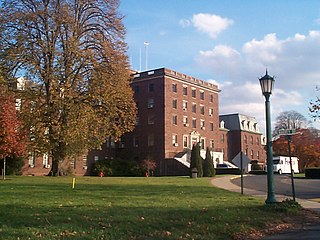
Connecticut Valley Hospital in Middletown, Connecticut, is a public hospital operated by the state of Connecticut to treat people with mental illness. It was historically known as Connecticut General Hospital for the Insane. It is a 100-acre (40 ha) historic district that was listed on the National Register of Historic Places in 1985.

The Merchants Avenue Historic District in a residential neighborhood southeast of the downtown in Fort Atkinson, Wisconsin, composed of 33 mostly large homes on large lots within six city blocks around Merchants Avenue. It was placed on the United States National Register of Historic Places in 1986.
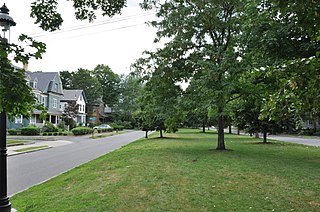
The Washington Park Historic District is a historic district in the village of Newtonville, in Newton, Massachusetts. It includes the following properties, dating to between 1870 and 1900: 4 to 97 Washington Park plus 5 and 15 Park Place. The focal point of the district is the city park which is located in the median of the street of the same name. On March 12, 2008, it was added to the National Register of Historic Places.
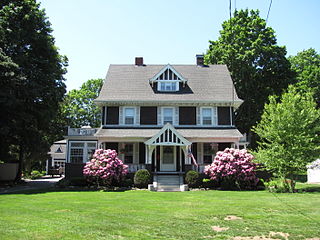
The House at 199 Summer Avenue in Reading, Massachusetts is designated as historic. The original two-and-a-half-story house was designed by architect Horace G. Wadlin and built in 1878 for Robert Kemp, leader of the popular Old Folks Concerts. The house was the second in Reading that Kemp had built; the first also is still standing.

The Yale Avenue Historic District is a residential historic district near the center of Wakefield, Massachusetts. It encompasses eight residential properties, all but one of which were developed in the 1860s and 1870s, after the arrival of the railroad in town. These properties were built primarily for Boston businessmen, and mark the start of Wakefield's transition to a suburb.
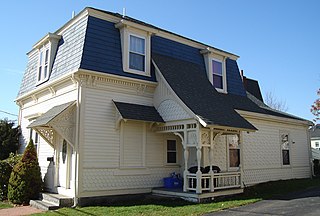
The Solon Dogget House is a historic house at 50 Union Street in Quincy, Massachusetts. The 1+1⁄2-story wood-frame house was built in 1872 by Henry G. Pratt, who sold it to Solon Dogget, a poet and artist. It is a well-preserved local example of Second Empire style, with a mansard roof, patterned shingling on the walls, and Queen Anne porches with spindled friezes and turned posts. It has Stick style bracketing on the door hoods.

The Alois and Annie Weber House is a historic building located in Keokuk, Iowa, United States. The significance of the three-story house is its association with the period of industrial growth in the city when it was built and as a fine local example of the Second Empire style. It features an asymmetrical concave mansard roof, decorative brackets, and pedimented dormer windows. The house is noteworthy for its tall narrow windows and high ceilings. Two additions were added to the rear of the house not long after the main house was built. The Queen Anne-style wraparound porch is supported by 14 classical columns. It also features a balustrade and spindlework along the beadboard ceiling. The house was listed on the National Register of Historic Places in 2002.

Nathan Goff Jr. House is a former historic home located at Clarksburg, Harrison County, West Virginia. It was built between 1880 and 1883, and was a three-story brick dwelling in a combined Queen Anne / Second Empire style. It featured a slate-covered mansard roof. It was the home of Nathan Goff Jr. (1843–1920) and his son Guy D. Goff (1866–1933), who both served as United States senators from West Virginia.
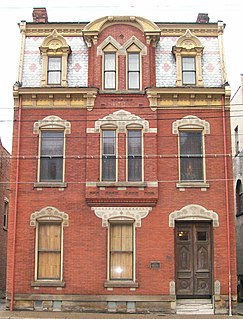
Robert W. Hazlett House is a historic home located at Wheeling, Ohio County, West Virginia. It was built in 1887, and is a three-story Second Empire style brick residence measuring 30 feet (9.1 m) wide and 112 feet (34 m) deep. It features a central hooded bay and a polychrome slate-covered mansard roof. The interior has many Queen Anne style details. In 1991, it housed Friends of Wheeling, Inc., a private, non-profit, historic preservation organization and four apartments.

Adam Clarke Nutt Mansion is a historic mansion located at Uniontown, Fayette County, Pennsylvania. It was built in 1882, and is a large three-story, irregularly shaped brick dwelling in the Queen Anne style. A front porch and porte cochere were added sometime before 1912. It has a truncated hipped roof, four tall chimneys, and a centered tower section. The property includes a contributing fieldstone wall and a non-contributing two-story carriage house with a mansard roof in the Second Empire style.

Samuel Warden House is a historic home located at Mount Pleasant, Westmoreland County, Pennsylvania. The house was built in 1886, and is a three-story, square brick dwelling in the Second Empire style, with Queen Anne and Eastlake style details. It has a mansard roof clad in octagonal, fishscale slate with dormer windows.
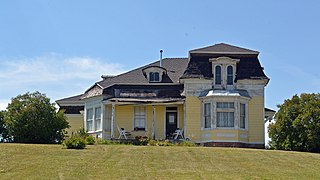
The Alfred Budge House, in Paris, Idaho, located at N. 1st, West at W. 1st, North, is a historic house that was built in 1880. It was renovated to include Second Empire styling, including a mansard roof, at a later date. The house has a complex design with three major sections and multiple smaller ones; while the mansard roof tops the main section, the house has eight roof components in total. It is listed on the U.S. National Register of Historic Places; the listing included six contributing buildings.

The Morgan County Courthouse, located at 300 W. State St. in Jacksonville, is the county courthouse of Morgan County, Illinois. The courthouse, the third built in Morgan County, was constructed from 1868 to 1869. Chicago architect Gurdon P. Randall designed the courthouse in a combination of the Italianate and Second Empire styles. The design is considered unusual among county courthouses, as counties generally preferred more traditional designs. Randall's design features an arched loggia surrounding the building's southern entrance, asymmetrical towers at the southern corners with mansard roofs and bracketed cornices, arched dormers within the towers' mansards, and an assortment of round-head and bulls-eye windows. One of the towers houses a 4,000 pounds (1,800 kg) bell, which was intended to be part of a clock that was never installed. A 9-foot (2.7 m) statue of Lady Justice, carved from a single block of pine, originally topped the front entrance; however, after losing its arms around 1872, the statue disappeared in the early 1900s and was never recovered.

The Todd Block is a historic commercial and civic building at 27-31 Main Street in Hinsdale, New Hampshire. It consists of two separate buildings that were conjoined in 1895, creating an architecturally diverse structure. The front portion of the building is a 2-1/2 story wood frame structure with Second Empire styling; it is only one of two commercial buildings built in that style in the town, and the only one still standing. It was built in 1862, and originally housed shops on the ground floor and residential apartments above. The front of the block has a full two-story porch, with turned posts, decorative brackets and frieze moulding. The corners of the building are pilastered, and the mansard roof is pierced by numerous pedimented dormers. The rear section of the building was built in 1895 as a hall for the local chapter of the Independent Order of Odd Fellows (IOOF). The principal feature of this three-story structure is its east facade, which has a richly decorated two-story Queen Anne porch.

The Whitney Park Historic District is a residential historic district on the west side of Bangor, Maine. The district contains 42 residential properties built between 1850 and 1910, a major period of the city's growth, and is anchored on its south by Whitney Park, a small triangular park at Hammond and Cedar Streets. The district was listed on the National Register of Historic Places in 1988, and is protected by the city's local historic district ordinance.
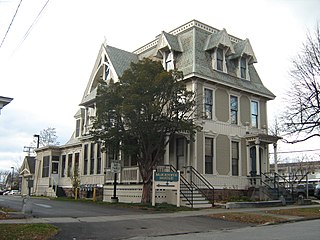
The Martin L. Kelsey House is a historic house at 43 Elmwood Avenue in Burlington, Vermont. Built in 1879 for a local merchant, it is a distinctive and architecturally varied house, with elements of the Second Empire, Queen Anne, and Stick styles on display. It was listed on the National Register of Historic Places in 1983, and now forms part of a senior housing complex.

21 Ranchhouse, located at 7570 Waha Road near Lewiston in Nez Perce County, Idaho, is a Queen Anne-style house built in 1886.It was listed on the National Register of Historic Places in 1978.
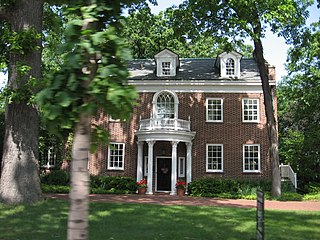
The North Broadway Street Historic District is a 28 acres (11 ha) historic district in De Pere, Wisconsin which was listed on the National Register of Historic Places in 1983. It included 47 contributing buildings and seven non-contributing ones.

The East Michigan Avenue Historic District is a residential historic district located at 300-321 East Michigan Avenue, 99-103 Maple Street, and 217, 300 and 302 East Henry in Saline, Michigan. It was listed on the National Register of Historic Places in 1985.

The N. S. Nielson House is a historic house in Mount Pleasant, Utah. It was built in 1892 for N. S. Nielson, an immigrant from Sweden who converted to The Church of Jesus Christ of Latter-day Saints and settled in Utah in 1868. Nielson became a large sheep farmer. He was also president of the Mount Pleasant Commercial and Savings Bank, and the mayor of Mount Pleasant from 1896 to 1897. His house was designed in the Victorian Eclectic architectural style, with Second Empire, Queen Anne, and Beaux-Arts Classical features, and a "two-story square tower with a bell-cast mansard roof." It has been listed on the National Register of Historic Places since July 26, 1982.






















